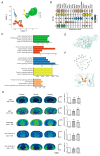A Single-Cell Atlas of the Substantia Nigra Reveals Therapeutic Effects of Icaritin in a Rat Model of Parkinson's Disease
- PMID: 39456437
- PMCID: PMC11505506
- DOI: 10.3390/antiox13101183
A Single-Cell Atlas of the Substantia Nigra Reveals Therapeutic Effects of Icaritin in a Rat Model of Parkinson's Disease
Abstract
Degeneration and death of dopaminergic neurons in the substantia nigra of the midbrain are the main pathological changes in Parkinson's disease (PD); however, the mechanism underlying the selective vulnerability of specific neuronal populations in PD remains unclear. Here, we used single-cell RNA sequencing to identify seven cell clusters, including oligodendrocytes, neurons, astrocytes, oligodendrocyte progenitor cells, microglia, synapse-rich cells (SRCs), and endothelial cells, in the substantia nigra of a rotenone-induced rat model of PD based on marker genes and functional definitions. We found that SRCs were a previously unidentified cell subtype, and the tight interactions between SRCs and other cell populations can be improved by icaritin, which is a flavonoid extracted from Epimedium sagittatum Maxim. and exerts anti-neuroinflammatory, antioxidant, and immune-improving effects in PD. We also demonstrated that icaritin bound with transcription factors of SRCs, and icaritin application modulated synaptic characterization of SRCs, neuroinflammation, oxidative stress, and survival of dopaminergic neurons, and improved abnormal energy metabolism, amino acid metabolism, and phospholipase D metabolism of astrocytes in the substantia nigra of rats with PD. Moreover, icaritin supplementation also promotes the recovery of the physiological homeostasis of the other cell clusters to delay the pathogenesis of PD. These data uncovered previously unknown cellular diversity in a rat model of Parkinson's disease and provide insights into the promising therapeutic potential of icaritin in PD.
Keywords: Parkinson’s disease; icaritin; neuroinflammation; oxidative stress; rotenone; single-cell RNA sequencing.
Conflict of interest statement
The authors declare no conflicts of interest.
Figures








Similar articles
-
Icaritin Provides Neuroprotection in Parkinson's Disease by Attenuating Neuroinflammation, Oxidative Stress, and Energy Deficiency.Antioxidants (Basel). 2021 Mar 29;10(4):529. doi: 10.3390/antiox10040529. Antioxidants (Basel). 2021. PMID: 33805302 Free PMC article.
-
Trib3 Is Elevated in Parkinson's Disease and Mediates Death in Parkinson's Disease Models.J Neurosci. 2015 Jul 29;35(30):10731-49. doi: 10.1523/JNEUROSCI.0614-15.2015. J Neurosci. 2015. PMID: 26224857 Free PMC article.
-
Human neuromelanin induces neuroinflammation and neurodegeneration in the rat substantia nigra: implications for Parkinson's disease.Acta Neuropathol. 2008 Jul;116(1):47-55. doi: 10.1007/s00401-008-0361-7. Epub 2008 Mar 15. Acta Neuropathol. 2008. PMID: 18343932
-
Nuclear Factor Kappa B: A Nobel Therapeutic Target of FlavonoidsAgainst Parkinson's Disease.Comb Chem High Throughput Screen. 2024;27(14):2062-2077. doi: 10.2174/0113862073295568240105025006. Comb Chem High Throughput Screen. 2024. PMID: 38243959 Review.
-
Converging roles of ion channels, calcium, metabolic stress, and activity pattern of Substantia nigra dopaminergic neurons in health and Parkinson's disease.J Neurochem. 2016 Oct;139 Suppl 1(Suppl Suppl 1):156-178. doi: 10.1111/jnc.13572. Epub 2016 Mar 23. J Neurochem. 2016. PMID: 26865375 Free PMC article. Review.
Cited by
-
Activity and Heterogeneity of Astrocytes in Neurological Diseases: Molecular Mechanisms and Therapeutic Targets.MedComm (2020). 2025 Aug 22;6(9):e70329. doi: 10.1002/mco2.70329. eCollection 2025 Sep. MedComm (2020). 2025. PMID: 40859959 Free PMC article. Review.
-
Dynamic Regulation of Cholesterol Metabolism Genes in Dopaminergic Neurons following Methamphetamine Treatment as Revealed by Single-Nucleus RNA Sequencing.bioRxiv [Preprint]. 2025 Jul 31:2025.07.28.667272. doi: 10.1101/2025.07.28.667272. bioRxiv. 2025. PMID: 40766573 Free PMC article. Preprint.
References
Grants and funding
LinkOut - more resources
Full Text Sources

